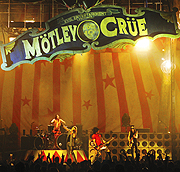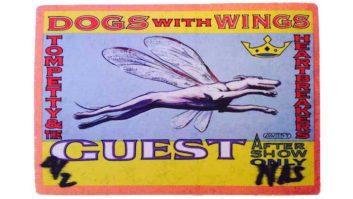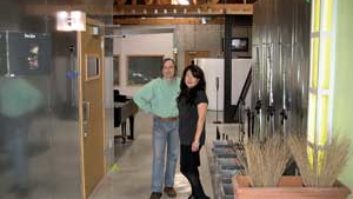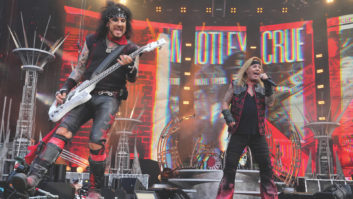
Only Mötley Crüe could pull something off like this for more than two hours without a support act and playing just about every night: deafening pyrotechnic explosions, the identifiable first guitar riffs, more pyros and/or a slew of flame pots, chorus of song, stripper-looking trapeze artist dangling from a rope while gyrating in sexual positions, more pyros, bassist/background vocalist Nikki Sixx proclaiming that “Mötley Crüe is f***ing back,” dwarfs and odd circus freaks harassing bandmembers onstage, end of song. Welcome to the Mötley Crüe arena rock show extravaganza — and man is it wonderful!

It’s hard to imagine that a band who hasn’t played live together since 1988 [drummer Tommy Lee has been working on side projects — on both sides of the camera] could get back on the road for a hefty round of sold-out arena dates, they haven’t killed each other (yet), don’t have an opening band until the summer festival leg and perform for a very appreciative, if not overzealous, audience.
While pulling out all the stops for their top hits, including “Girls, Girls, Girls” (for which the Crüe, minus guitarist Mick Mars, rides out on miked — yes, miked with Shure MX184 lavs — Harleys for the opening riff), “Dr. Feelgood,” “Home Sweet Home” (complete with lighted Bics in the air), “Kickstart My Heart” and “Shout at the Devil,” the band also dragged out older tunes (“Too Fast for Love,” “Red Hot”), ending the show with covers of The Beatles’ “Helter Skelter” and the Sex Pistols’ “Anarchy in the UK” — all in classic Crüe decadence. Mix caught up with the Crüe and crew on their Red White & Crue…Better Live Than Dead tour (out in support of their February 1 release, Red, White and Crüe, a 37-track, double-disc retrospective) in late March at the Oakland Arena (Oakland, Calif.) — and we were in for a wild ride.

FOH engineer Dave Natale camped out in his FOH compound, complete with two Yamaha PM4000 boards
HE’S THE ONE THEY CALL DR. SOUND GOOD
The last time Mix spoke with front-of-house engineer Dave Natale, he was mixing for Lenny Kravitz’s 2002 tour. Since then, he’s been on the road with Liza Minnelli, Fleetwood Mac and Lionel Ritchie’s UK tour — polar opposites of the Crüe’s circus. “Although the type of music is different,” Natale says, “my approach is basically the same. It is just louder. I do use more limiters on this than I used before.” Natale puts dbx 903 compressor/limiters on the bass DI, bass mic (Sennheiser 409), guitar left/right and dry Theremin and Vince Neil’s vocal mic (a Shure Beta 58).
Just as the show itself is “big” in its theatrics, that magnitude is also shared in the audio gear: Both front-of-house and monitor worlds are employing two consoles because drummer Tommy Lee plays three kits, maxing out the number of inputs offered in just one board. “I am hopelessly caught up in the analog world,” Natale says. “As always, I’m using two Yamaha PM4000s, each with 40 mono and 12 stereo channels. I will continue to use these consoles until they completely disintegrate. Anyone that knows me knows that. As far as consoles go, I avoid any ‘smart’ consoles: ones that have a microprocessor in it. I am leery about using a console that can do whatever it wants, anytime that it wants without me telling it to.
“I am using much of the same outboard gear that I always use,” he continues. “I have six Yamaha SPX-990s for reverb, slap, delay and flanging. I change the programs of the SPXs with a Yamaha MPC-1 MIDI program changer. In addition to the dbx 900 rack, I also use four channels of Aphex 612 noise gates on Tommy’s kick and three toms. I have an Alesis MasterLink hard drive recorder and a Panasonic 3800 DAT.”

Wall of sound, wall of fire: Mötley Crüe’s stage antics were amplified through a Clair Bros. i4 system.
However, what’s not so basic for Natale is how loud the show is, partly due to the “wall of sound” onstage: 16 Marshall cabs (eight stacks) for guitarist Mars (though Natale says that he really only uses 12) and Sixx’s eight 8×10s — three or four of which are on. “I mix this band almost exactly as I mix any other band,” Natale says. “Only the overall volume changes. We are playing a wide variety of venues on this tour. We play arenas with high ceilings, convention centers with low ceilings and we have played The Joint at the Hard Rock in Vegas. That was interesting to mix this band in that tiny venue. The band has exceptional stage volume: It is a challenge to get over Mick Mars’ massive guitar sound, as well as the monitor volume that [monitor engineer] Mike Adams and the band generate.”
An all-Clair Bros./Showco tour, the Crüe is heard through a Clair Bros. i4 system: 40 i4s, 36 i4Bs, 14 S4 subs and eight P2s for frontfill. Amps are Crest 10004s and QSC 9s on the i4s and i4Bs, as well as Carver 2.0s on the S4 sub lows and P2s. “I EQ the system every day with a Sheffield Labs direct-to-disc recording called
James Newton-Howard and Friends
that I have been using for the past 20 years,” the engineer says. “In my opinion, it has a fabulous drum sound and it is good music.” Natale uses about eight minutes of that CD to EQ, then Kirk “Eek” Shreiner (P.A. system tech and crew chief) uses a Lake wireless system processor to fine-tune specific areas and touch up the EQ. “Kirk also specifies the size and shape of the arrays every day. I trust him implicitly. We have worked together on many tours.”
One man, three kits, 33 inputs: Drummer Tommy Lee pounds at his stage-right (pictured left) and stage-left kits. Both kits are flown about 30 feet above the stage.

Sixx was at a show that had a line array system and really liked the way it sounded. “The band had a few companies in mind,” Shreiner says, “but Nikki asked Dave [Natale] which company he liked and because of [Natale’s] long affiliation and familiarity with [Clair Bros./Showco], Dave suggested that company. The band also liked the fact that Clair Bros./Showco has offices worldwide.
“Basically, the P.A. hangs in approximately the same place, relative to the stage, every day,” he continues. “I just know from hanging this P.A. for so long where it is going to cover. The biggest difference — from venue to venue — is the height. We just fly as much as we can without blocking sight lines. If it is a low building [such as Las Vegas’ The Joint], generally there are not as many seats and so a scaled-down version of the P.A. works out well. Dave and I have been working together for a long time and he trusts my opinion, which is nice!”
Knowing that the P.A. is set and ready to go is necessary for Natale, who also has to contend with the array of microphones used onstage, including miking three drum kits — two of which are hung 25 feet above the stage that Lee “flies” between and plays during his 10-minute drum solo — that require 33 inputs. For the flown stage-right kit (which is basically one 55-gallon drum and two half-barrels, as in beer), Natale uses a Beyer M88 (one 55-gallon drum), AKG 414s (overheads) and Sennheiser 409s (kegs). For the other flown kit (which is all metal), Natale uses line transformers for the D-Drum and E-mu modules and AKG 460s for overheads. The stage kit is miked with Beyer M88 and Shure SM91 (kick), SM57 (snare top and bottom), AKG 460s (hi-hats, cowbell and ride), Beyer Opus 87 (toms) and AKG 414s (overheads).
From left: monitor engineer Mike Adams, and monitor techs Joe Manges and Little Jon Edmonds of Clair Bros./Showco

KICKSTART THE MONITORS
Showco monitor mixer Adams (who has worked for rockers John Mayer, Guns ‘N Roses, Limp Bizkit, Ted Nugent and KISS, among others) is also working two boards: Midas 3000s using 80 inputs and 24 outputs. Onstage, Adams ensures that the stage volume isn’t overwhelming for the band, especially with a massive amount of speakers and amps. For example, just lining the edge and sides of the stage are 30 Showco Prism SRM wedges. “In addition to their ears [Shure PSM700 and Sennheiser EW300IEM in-ear monitoring units], each bandmember has stereo wedge mixes,” Adams says. “The deck splits left/right all the way across downstage, so there’s always a sweet stereo spot for them to go to. The wedges live under the deck and project through grilles. Tommy’s drumfill is stereo wedges/mono subs [three Showco Prism subs, six Showco B1 subs and four Showco SRM wedges] and the sidefills [eight Showco Prism Blue cabs that fly and eight Showco Prism subs that are decked] are in stereo.” Amps are Crown 3600 X12 on the SRM wedges and Prism Blues and Crown 3200 on the Prism and six B1 subs.
“I don’t have a problem with the stage volume,” Adams says. “It’s loud, make no mistake. I have worked with Dave to not interfere with his FOH mix as much as possible. This includes keeping things sonically neat and tidy up here. The highpass filter is your best friend in this circumstance.”
P.A. system engineer Kirk “Eek” Schreiner on one of the Crüe’s choppers

Other outboard gear that Adams relies on includes two Eventide H3000 Harmonizers, two Yamaha SPX-990 digital effects units, four dbx 160A compressor/limiters, 12 dbx 903 compressor/limiters, six Drawmer DS320 noise gates and an Avalon AD2044 stereo compressor/limiter. With all of this gear in his arsenal, Adams chooses to stay as much out of the way of the band’s sound as possible. “They do it all,” he contends. “I just turn it up or down. That’s my job. But I’m not alone out here. My ‘dog’ is Jon Edmonds, a spectacular systems engineer who is basically a ‘second’ mixer out here. Joe Manges is our other little fighter on deck and is an i4 P.A. hanging mofo. Kirk ‘Eek’ Shriener is one of the finest crew chiefs in the business. I can’t say enough about the sound team out here.”And good thing, too, as the tour heads off to the UK and Europe through mid-June. In August and September, the band will play 40-plus North American amphitheatres before heading to Australia, New Zealand and Japan in November and December.Sarah Benzuly is Mix’s managing editor.




